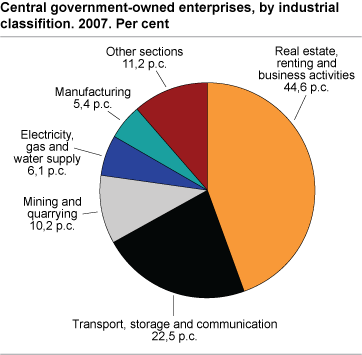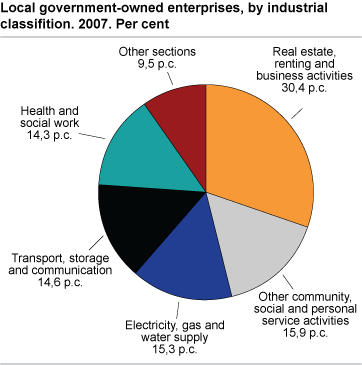Content
Published:
This is an archived release.
About 3 000 publicly owned enterprises
There were approximately 2 970 publicly owned non-financial enterprises at the end of 2007. About 2 360 enterprises, or 79.5 per cent, were local government owned enterprises, while the rest was owned by the central government.
Mostly, the 610 central government owned enterprises were organised in the five major industrial classification areas. These were real estates activities and business activities (44.6 per cent), transport and communication (22.5 per cent), mining and extraction (10.2 per cent), energy and water supply (6.1 per cent) and industry (5.4 per cent).
The Local government owned enterprises operate in five major industrial classification areas. These are real estates activities and business activities (30.4 per cent), other social and personal services (15.9 per cent), energy and water supply (15.3 per cent), transport and communication (14.6 per cent) and health and social services (14.3 per cent).
The number of publicly owned non-financial enterprises increased significantly during the period from 2003 to 2006. One explanation for the recent development is the fact that some of the major enterprises have been reorganised either as a result of takeovers or buying and selling. The significant increase in the number of the enterprises from the period 2003 to 2005 is, however, also a result of the improved method of data collection in Statistics Norway. The number of the enterprises has been relatively stable during the last three years, and was about 3000.
Major business organisation forms
Mostly, the central government owned enterprises were organised as limited companies or public limited companies. About 578 enterprises or 95.1 per cent had this type of business organisation form by the end of 2007, and this has been relatively stable during the period starting from 2002.
Somewhat 1 859 or 78.8 per cent local government owned enterprises were organised as limited companies at the end of 2007. Other common forms of companies include municipal or county municipal enterprises, local government companies incorporated by the local government Act and inter municipal enterprises.
Geographical concentration
In 2007 most of the central government owned enterprises were located in the four major counties Oslo, Rogaland, Akershus, and Sør Trøndelag by 164, 92, 88 and 63 enterprises respectively. Generally, about 67 per cent of the central government owned enterprises were geographically located in these four counties. About 41.4 per cent of this enterprise population was registered in Oslo and Akershus. There was somehow little geographical location difference among the local government owned enterprises.
The basis of the computationThe statistics comprises publicly owned non-financial enterprises. An enterprise is defined as publicly owned if the majority shareholder in the enterprise directly or indirectly belongs to the central government or the local government. A local government enterprise can be owned by a municipality or by a county municipality.
The statistics also covers municipal and county municipal companies, inter municipal companies and companies incorporated by the local government Act. One or more local government wholly owns these business entities. Inter municipal companies belong in the municipality where the head office is located. |
Tables:
- Table 1 Public non-financial corporation. Number. 2002-2007
- Table 2 Central government-owned enterprises, by industrial classification. Number and per cent. 2002-2007
- Table 3 Local government-owned enterprises, by industrial classification. Number and per cent. 2002-2007
- Table 4 Central government-owned enterprises, by organizational structure. Number and per cent. 2002-2007
- Table 5 Local government-owned enterprises, by organizational structure. Number and per cent. 2002-2007
- Table 6 Central government-owned enterprises, by county. Number and per cent. 2002-2007
- Table 7 Local government-owned enterprises, by county. Number and per cent. 2002-2007
Contact
-
Statistics Norway's Information Centre
E-mail: informasjon@ssb.no
tel.: (+47) 21 09 46 42


